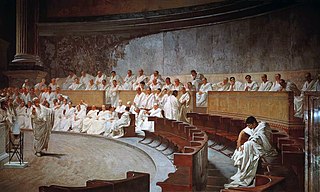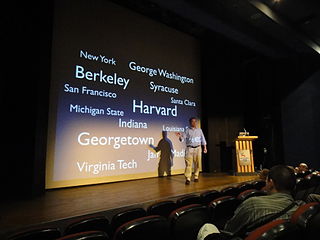
Public speaking, also called oratory or oration, has traditionally meant speaking in person to a live audience. Today it includes speaking, formally or informally, to an audience through technology – live, pre-recorded, or at a distance.

Rhetoric is the art of persuasion, which along with grammar and logic, is one of the three ancient arts of discourse. Rhetoric aims to study the techniques writers or speakers utilize to inform, persuade, or motivate particular audiences in specific situations. Aristotle defines rhetoric as "the faculty of observing in any given case the available means of persuasion" and since mastery of the art was necessary for victory in a case at law, for passage of proposals in the assembly, or for fame as a speaker in civic ceremonies, he calls it "a combination of the science of logic and of the ethical branch of politics". Rhetoric typically provides heuristics for understanding, discovering, and developing arguments for particular situations, such as Aristotle's three persuasive audience appeals: logos, pathos, and ethos. The five canons of rhetoric or phases of developing a persuasive speech were first codified in classical Rome: invention, arrangement, style, memory, and delivery.
A communication disorder is any disorder that affects an individual's ability to comprehend, detect, or apply language and speech to engage in dialogue effectively with others. The delays and disorders can range from simple sound substitution to the inability to understand or use one's native language.
Glossophobia or speech anxiety is the fear of public speaking. The word glossophobia derives from the Greek γλῶσσα glossa (tongue) and φόβος phobos The causes of glossophobia are uncertain but explanations include communibiology and the illusion of transparency. Further explanations range from nervousness produced by a lack of preparation to, one of the most common psychiatric disorders, Social anxiety disorder (SAD).

A presentation conveys information from a speaker to an audience. Presentations are typically demonstrations, introduction, lecture, or speech meant to inform, persuade, inspire, motivate, build goodwill, or present a new idea/product. Presentations usually require preparation, organization, event planning, writing, use of visual aids, dealing with stress, and answering questions. “The key elements of a presentation consists of presenter, audience, message, reaction and method to deliver speech for organizational success in an effective manner.” Presentations are widely used in tertiary work settings such as accountants giving a detailed report of a company's financials or an entrepreneur pitching their venture idea to investors. The term can also be used for a formal or ritualized introduction or offering, as with the presentation of a debutante. Presentations in certain formats are also known as keynote address. Interactive presentations, in which the audience is involved, are also represented more and more frequently. Instead of a monologue, this creates a dialogue between the speaker and the audience. The advantages of an interactive presentation is for example, that it attracts more attention from the audience and that the interaction creates a sense of community.

A keynote in public speaking is a talk that establishes a main underlying theme. In corporate or commercial settings, greater importance is attached to the delivery of a keynote speech or keynote address. The keynote establishes the framework for the following programme of events or convention agenda; frequently the role of keynote speaker will include that of convention moderator. It will also flag up a larger idea—a literary story, an individual musical piece, or event.
Extemporaneous Speaking is a speech delivery style/speaking style, and a term that identifies a specific forensic competition. The competition is a speech event based on research and original analysis, done with a limited-preparation; in the United States those competitions are held for high school and college students. In a Extemporaneous Speech competition, enrolled participants prepare for thirty minutes on a question related to current events and then give a seven-minute speech responding to that question. The extemporaneous speaking delivery style, referred to as "off-the-cuff", is a type of delivery method for a public presentation, that was carefully prepared and practiced but not memorized.

A motivational speaker is a speaker who makes speeches intended to motivate or inspire an audience. Such speakers may attempt to challenge or transform their audiences. The speech itself is popularly known as a pep talk.
Robert L. Scott was an American scholar influential in the study of rhetorical theory, criticism of public address, debate, and communication research and practice. He was professor emeritus in the Communication Studies Department at the University of Minnesota. He is the author of five books, numerous articles in speech, communications, philosophy, and rhetoric journals, and contributed many book chapters. His article "On Viewing Rhetoric As Epistemic", is considered one of the most important academic articles written in rhetorical studies in the past century.

English is a West Germanic language in the Indo-European language family, with its earliest forms spoken by the inhabitants of early medieval England. It is named after the Angles, one of the ancient Germanic peoples that migrated to the island of Great Britain. Existing on a dialect continuum with Scots and then most closely related to the Low Saxon and Frisian languages, Modern English is genealogically Germanic. However, its vocabulary also shows major influences from French and Latin, plus some grammar and a small amount of core vocabulary influenced by Old Norse. Speakers of English are called Anglophones.
Communication noise refers to influences on effective communication that influence the interpretation of conversations. While often looked over, communication noise can have a profound impact both on our perception of interactions with others and our analysis of our own communication proficiency.
Rhetorical stance is the position of a speaker or writer in relation to audience, topic, and situational context. Rhetoric is the art of effective or persuasive speech. Stance is an individual's attitudes in emotional and intellectual matters, or a philosophical position in a logical argument. Therefore, a rhetorical stance is an effective argument in favor of a particular position in order to persuade others to agree.

Communication apprehension is a degree or measure of the anxiety triggered by the real or anticipated communication act, as defined by James C. McCroskey. The fear of judgment from the audience and self-image are two factors which fuel the anxiety. Since communication can be oral or written, communication apprehension (CA) is divided into oral communication apprehension (OCA) and written communication apprehension (WCA).
Source credibility is "a term commonly used to imply a communicator's positive characteristics that affect the receiver's acceptance of a message." Academic studies of this topic began in the 20th century and were given a special emphasis during World War II, when the US government sought to use propaganda to influence public opinion in support of the war effort. Psychologist Carl Haviland and his colleagues worked at the War Department upon this during the 1940s and then continued experimental studies at Yale University. They built upon the work of researchers in the first half of the 20th century who had developed a Source-Message-Channel-Receiver model of communication and, with Muzafer Sherif, developed this as part of their theories of persuasion and social judgement.

Beyond the First Amendment: The Politics of Free Speech and Pluralism is a book about freedom of speech and the First Amendment to the United States Constitution, written by author Samuel Peter Nelson. It was published by Johns Hopkins University Press in 2005. In it, Nelson discusses how the more general notion of free speech differs from that specifically applied to the First Amendment in American law.
An orator, or oratist, is a public speaker, especially one who is eloquent or skilled.

Nick Morgan is an American speaking coach and author.

Pseudo-listening is a type of non-listening that consists of appearing attentive in conversation while actually ignoring or only partially listening to the other speaker. The intent of pseudo-listening is not to listen, but to cater to some other personal need of the listener. The word pseudo-listening is a compound word composed of the individual words pseudo, and listening. An example of pseudo-listening is trying to multitask by talking on the phone while watching television or completing work. Pseudo-listening is the most ineffective way to communicate because after the conversation one will not have retained much of the information that was said.
Diane DiResta is an American speaker, author, media trainer, speech coach and certified speech pathologist based in New York City. DiResta has worked with celebrities and corporations to train them in communication skills.

The Zone of interaction is the area of an audience in which speaker and audience members can make eye contact.











